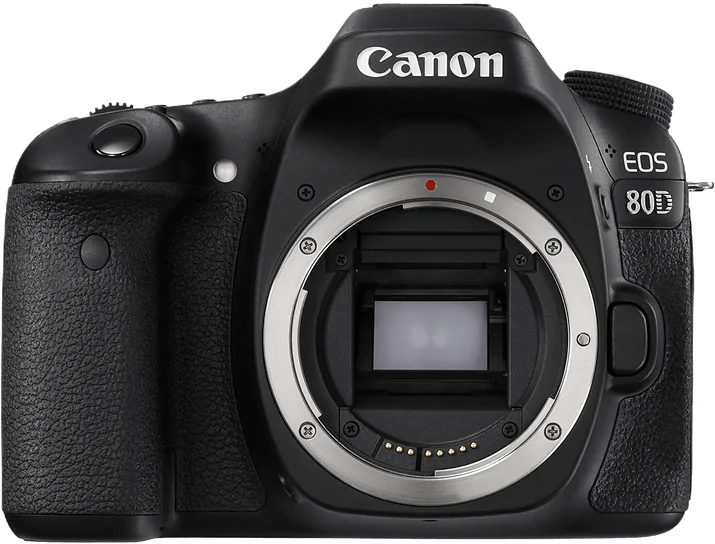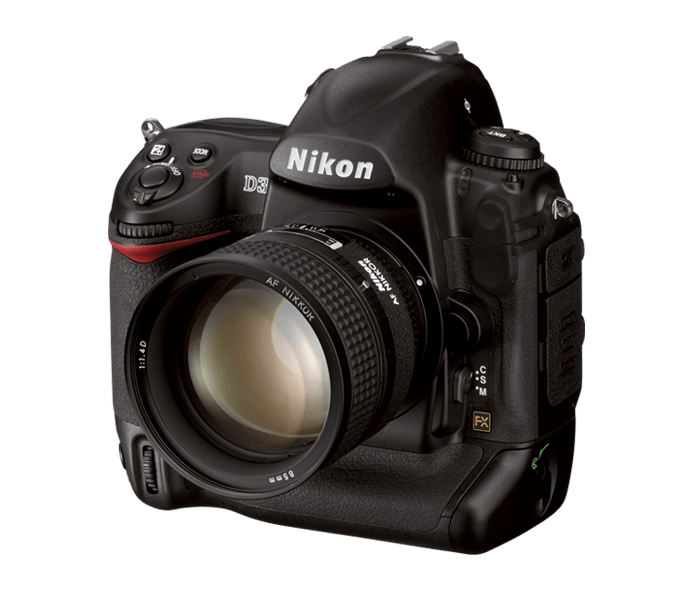Canon EOS 80D vs Nikon D3 Comparison
Canon EOS 80D

Nikon D3

The Canon EOS 80D outperforms the Nikon D3 with a score of 64/100 compared to 58/100. Both cameras are DSLRs and were released in 2016 and 2007, respectively. They share some common specifications, including their camera type and announcement dates.
The Canon EOS 80D has a few advantages over the Nikon D3, such as a lower launch price of $1200 compared to $4300, a more compact size of 139 x 105 x 79mm, and a lighter weight at 730g or 1.61lbs. These features make the Canon EOS 80D more affordable and portable than its competitor.
On the other hand, the Nikon D3 has a larger size of 160 x 157 x 88mm and a heavier weight of 1300g or 2.87lbs, which might be preferred by some users for its sturdiness and durability.
Taking these factors into account, the Canon EOS 80D is a better choice for those who prioritize affordability and portability, while the Nikon D3 might be more suitable for users who value a more robust build.
Canon EOS 80D vs Nikon D3 Overview and Optics
The Canon EOS 80D outperforms the Nikon D3 in optics with a score of 63/100 compared to the Nikon D3’s score of 56/100. Both cameras share common specifications, such as a CMOS sensor, no image stabilization, and similar processors (Canon’s Digic 6 and Nikon’s Expeed).
The Canon EOS 80D has a higher megapixel count at 24.2, allowing for more detailed and sharper images. Additionally, the sensor size of APS-C is more suitable for general photography and versatile shooting conditions. The Canon EOS 80D also uses a Canon EF-S lens mount, providing users with a wide range of lens options.
On the other hand, the Nikon D3 has its own advantages. With a shooting speed of 11, the Nikon D3 is more capable of capturing fast-moving subjects and is better suited for sports and action photography. Moreover, the D3’s full-frame sensor size delivers better low-light performance and shallower depth of field. The Nikon F FX lens mount also offers a vast selection of lens options.
Despite having a lower DXOMARK score of 79 for the sensor compared to the Nikon D3’s score of 81, the Canon EOS 80D still manages to provide better overall optics. This is due to its higher megapixel count and versatile sensor size. The Nikon D3, however, excels in shooting speed and low-light performance.
In the end, the Canon EOS 80D proves to be the better choice for photographers seeking higher image quality and versatility in their camera optics. The Nikon D3 remains a strong option for those prioritizing shooting speed and low-light performance.
Canon EOS 80D vs Nikon D3 Video Performance
When it comes to video capabilities, there is a significant difference between the Canon EOS 80D and the Nikon D3. The Nikon D3 does not have any video functionality, making it impossible to capture video with this camera. On the other hand, the Canon EOS 80D does offer video capabilities, which will be discussed in more detail below.
The Canon EOS 80D has a video score of 70/100. This camera can record Full HD videos with maximum dimensions of 1920 x 1080 pixels. The EOS 80D also offers a maximum video frame rate of 60 frames per second, allowing for smooth and detailed video capture. Additionally, the Canon EOS 80D has a built-in time-lapse functionality, which enables users to create stunning time-lapse videos without the need for additional software or equipment.
Taking into account the video capabilities of both cameras, the Canon EOS 80D is the better choice for those who require video functionality in their camera. The Nikon D3, lacking any video features, is not suitable for users who need to capture video content. Therefore, the Canon EOS 80D is the more versatile option when considering video capabilities.
Canon EOS 80D vs Nikon D3 Features and Benefits
The Canon EOS 80D outperforms the Nikon D3 in features with a score of 70/100 compared to the Nikon D3’s 54/100. Both cameras share some specifications, such as a 3-inch screen size and the absence of GPS functionality.
The Canon EOS 80D surpasses the Nikon D3 in various aspects. It has a higher screen resolution of 1,040,000 dots, compared to the D3’s 922,000 dots, providing clearer and sharper image previews. The 80D also features a touchscreen, making it convenient for users to navigate through menus and adjust settings quickly. Additionally, the 80D has a flip screen, which is beneficial for capturing images from different angles and shooting in tight spaces. The presence of WIFI in the 80D enables users to transfer images wirelessly and control the camera remotely.
On the other hand, the Nikon D3 lacks some of the modern features found in the 80D, such as a touchscreen, flip screen, WIFI, and Bluetooth. However, it is essential to note that the D3 is an older model, which may account for the absence of these features. Despite the lower score in features, the D3 may still be a suitable choice for photographers who prioritize other aspects, such as image quality and performance.
In comparing these two cameras, the Canon EOS 80D offers more advanced features, making it a better choice for photographers seeking convenience and versatility. The Nikon D3, while lacking in features, may still be a viable option for those who do not require the additional functionalities provided by the EOS 80D.
Canon EOS 80D vs Nikon D3 Storage and Battery
The Nikon D3 triumphs over the Canon EOS 80D in storage and battery with a score of 87/100 compared to 43/100. Both cameras lack USB charging, but similarities end there.
Nikon D3’s superior performance stems from its two memory card slots, accepting Compact Flash (Type I or II) cards. In contrast, the Canon EOS 80D has a single slot for SD/SDHC/SDXC (UHS-I compatible) cards. The D3’s dual slots offer users more storage flexibility and backup options.
The D3 also surpasses the 80D in battery life, lasting an impressive 4300 shots with its EN-EL4a battery. The 80D’s LP-E6N battery pales in comparison, providing only 960 shots. This significant difference makes the Nikon D3 ideal for extended shooting sessions.
The Canon EOS 80D, however, offers a more modern memory card format with its SD/SDHC/SDXC compatibility, which is more widely available and affordable than the Compact Flash cards used by the Nikon D3.
Despite the Canon EOS 80D’s advantage in memory card format, the Nikon D3’s superior storage capacity and battery life make it the clear winner in this comparison.
Canon EOS 80D vs Nikon D3 – Our Verdict
Are you still undecided about which camera is right for you? Have a look at these popular comparisons that feature the Canon EOS 80D or the Nikon D3:

